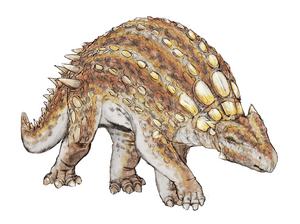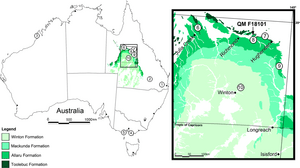Minmi paravertebra facts for kids
Quick facts for kids Minmi |
|
|---|---|
 |
|
| Hypothetical restoration, mainly based on Kunbarrasaurus | |
| Scientific classification | |
| Genus: |
Minmi
|
| Species: |
paravertebra
|
Minmi is a type of small, plant-eating dinosaur known as an ankylosaurian. It lived in Australia during the early Cretaceous Period, which was about 133 to 120 million years ago. Minmi was an armored dinosaur, meaning it had bony plates on its body for protection.
Contents
Discovering the Minmi Dinosaur

In 1964, a scientist named Dr. Alan Bartholomai found a special rock containing the bones of an ankylosaurian dinosaur. This discovery happened in Queensland, Australia, near a place called Minmi Crossing.
Later, in 1980, another scientist named Ralph E. Molnar officially named and described this new dinosaur. He called it Minmi paravertebra. The name Minmi comes from Minmi Crossing, where it was found. The word "minmi" might mean a large lily in the local Aboriginal language. The second part of the name, paravertebra, refers to some unusual bone pieces found near its backbone.
The first Minmi skeleton found was only partly complete. It was missing its head. This discovery was very important because it was the first time an armored dinosaur was found in the Southern Hemisphere.
Finding More Minmi Fossils
In 1989, a much more complete skeleton was found. This one included the skull and showed its full body armor. For a long time, people thought this was another Minmi. Many books and pictures of Minmi were actually based on this second skeleton.
However, in 2015, scientists realized this second skeleton was different enough to be its own type of dinosaur. They named it Kunbarrasaurus. This means that the original Minmi (Minmi paravertebra) is still known from its first, less complete skeleton.
Between 1989 and 1996, several other Minmi fossils were found. These included parts of hips, ribs with armor plates, and leg bones. Each new find helped scientists learn more about this ancient Australian dinosaur.
What Minmi Looked Like
Minmi was a small, four-legged dinosaur that ate plants. It had special armor to protect itself. In 2016, scientists estimated that Minmi was about 3 meters (10 feet) long. It probably weighed around 300 kilograms (660 pounds), which is about the same as a small car.
Compared to other armored dinosaurs, Minmi had longer legs. Scientists think these longer legs might have helped it run quickly to hide from big predators. It could have found cover under bushes if a large meat-eating dinosaur tried to attack it.
Minmi's Unique Armor
One very special thing about Minmi was its unique armor. Unlike other ankylosaurians, Minmi had flat, bony plates that ran horizontally along the sides of its backbone. These plates are what gave it the name paravertebra.
Scientists first thought these were special bony tendons. Later research suggested they might be unique features that help identify Minmi from other similar dinosaurs. This means Minmi is considered a valid and distinct type of dinosaur.
Minmi's Place in the Dinosaur Family Tree
Scientists use something called cladistic analysis to figure out how dinosaurs are related. When Minmi was first discovered, it was placed in the group of armored dinosaurs called Ankylosauria.
Later, some scientists thought Minmi might belong to a group called Nodosauridae. However, more recent studies suggest that Minmi is one of the earliest known members of the Ankylosauridae family. This means it's a very "basal" or early form of this group.
Some scientists even suggest that Minmi and Kunbarrasaurus might be part of their own very old and basic group of armored dinosaurs called Minmidae. This group might have developed separately in the ancient continent of Gondwana.
What Minmi Ate
In 2000, scientists Ralph E. Molnar and Harold Trevor Clifford studied Minmi's diet. They found that Minmi was a "low browser" and "grazer." This means it ate plants that grew close to the ground.
Its diet likely included things like seeds, fruit, and different kinds of flowering plants. It also probably ate ferns. Minmi's diet was similar to its cousin, Kunbarrasaurus. However, Kunbarrasaurus might have eaten more tough, fibrous plants, while Minmi did not.
See also
 In Spanish: Minmi paravertebra para niños
In Spanish: Minmi paravertebra para niños

